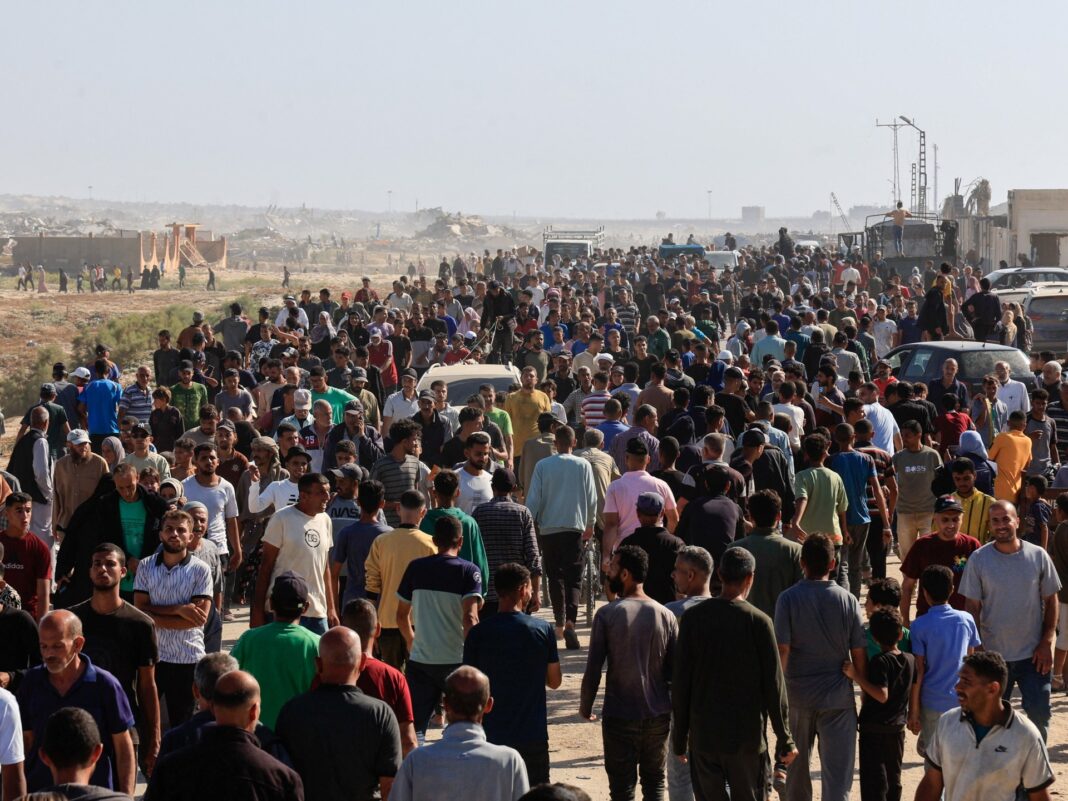In punishing midday heat, thousands of Palestinians have clambered over fences and pushed through packed crowds to reach life-saving supplies, laying bare the scale of the humanitarian catastrophe inflicted on Gaza by Israel’s three-month blockade of aid.
With the buzz of military helicopters overhead, Israeli military gunfire rattled in the background on Tuesday as desperate crowds struggled to reach an Israeli-United States food distribution point on its first day of operation.
TV footage from Rafah in southern Gaza showed long lines of people funnelling through a wired corridor into a large open field where aid packages brought by the Gaza Humanitarian Foundation (GHF) were stacked. Later, desperately hungry Palestinians, including women and children, were seen tearing down fences as people forced their way towards the GHF distribution point.
“We have been dying of starvation. We have to feed our children who want to eat. What else can we do? I could do anything to feed them,” a Palestinian father told Al Jazeera.
“We saw people running, and we followed them, even if it meant taking a risk and it was scary. But fear is not worse than starvation.”
After thousands of Palestinians stormed the aid distribution centre, the Israeli military said its forces did not direct gunfire towards them but rather fired warning shots in an area outside it. It said in a statement that control over the situation had been established and aid distribution would continue as planned.
But Gaza officials accused Israel of failing to manage the aid amid widespread hunger and relentless bombing of civilians, including children.
“What happened today is conclusive evidence of the occupation’s failure to manage the humanitarian crisis it deliberately created through a policy of starvation, siege, and bombing,” the Government Media Office in Gaza said in a statement after the mayhem.
The aid by GHF, a foundation backed by the US and endorsed by Israel, arrived in Gaza despite allegations that the new group did not have the experience or capacity to bring relief to more than two million Palestinians in Gaza.
The United Nations and aid groups say the organisation does not abide by humanitarian principles and could serve to further displace people from their homes as Palestinians move to receive aid from a limited number of distribution sites.
‘Reckless, inhumane plan’
UN spokesperson Stephane Dujarric said seeing thousands of Palestinians storming the aid site was “heartbreaking”.
“We and our partners have a detailed, principled, operationally sound plan supported by member states to get aid to a desperate population,” he told reporters. “We continue to stress that a meaningful scale-up of humanitarian operations is essential to stave off famine and meet the needs of all civilians wherever they are.”
The chaos underscored the staggering level of hunger gripping Gaza. According to the latest Integrated Food Security Phase Classification report, 1.95 million people – 93 percent of the enclave’s population – are facing acute food shortages.

Aid groups have warned for months that starvation in Gaza is being used by Israel as a weapon of war.
“This is not how aid is done,” Ahmed Bayram, spokesperson for the Norwegian Refugee Council, told Al Jazeera, describing the scene in Rafah as the “inevitable consequence of a reckless and inhumane plan”.
“These are the scenes we have literally been warning about all month now. It spread chaos. It spread confusion. And this is the result,” he said.
“I think the best thing that can be done now is for this plan to be cancelled, to be reversed and for us professional humanitarians in the UN and NGOs to do our job. There are tonnes and tonnes of aid waiting across the border. [It’s a] very simple decision: open the gates and keep them open.”
The GHF, a Swiss-based entity formed in February through back-channel meetings between Israeli-linked officials and business figures, was made the lead distributor of aid by Israel. Meanwhile, Israel has blocked the UN and other international organisations from bringing in aid.
Despite being promoted as a neutral body, the GHF’s close ties to Israel and the US have prompted widespread condemnation. Its former head suddenly resigned this week, citing the foundation’s inability to uphold the core humanitarian principles of “neutrality, impartiality and independence”.
According to a report in The New York Times, the GHF emerged from “private meetings of like-minded officials, military officers and businesspeople with close ties to the Israeli government”.
Israel has said its forces are not involved in the physical distribution of aid although it backs the system’s use of biometric screening, including facial recognition, to vet aid recipients. Palestinians fear it is another Israeli tool of surveillance and repression.
Critics have also warned that the GHF’s structure – and its concentration of aid in southern Gaza – could serve to depopulate northern Gaza, as planned by the Israeli military.
‘This is definitely not enough’
While the previous UN-led distribution network operated about 400 sites across the strip, the GHF has set up only four “mega-sites” for Gaza’s 2.3 million residents.
In Deir el-Balah in central Gaza, Al Jazeera’s Hind Khoudary reported that many of the food parcels being handed out were inadequate to sustain families.
Khoudary described a typical food box with 4kg (8.8lb) of flour, a couple of bags of pasta, two cans of fava beans, a pack of tea bags and some biscuits. Other food parcels contained lentils and soup in small quantities.
Although the GHF said it distributed about 8,000 food boxes on Tuesday, which it claimed amounted to 462,000 meals, Khoudary said the rations would barely sustain a single family for long.
“This is definitely not enough, and it is not enough for all the humiliation that Palestinians are going through to receive these food parcels,” she said.


